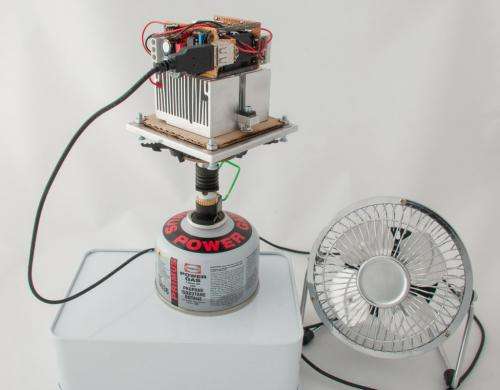May 3, 2013 weblog
DIY thermoelectric device charges hiker's smartphone

(Phys.org) —Whether you're in a city café hunting down a spare outlet or camping and worrying about losing outside contact, the problem is the same, a smartphone about to lose power just when you need it the most. What to do? A problem-solver who is into hiking and backpacking has an answer. He shows, step to step, how to construct a portable thermoelectric emergency generator. David Johansson, who used the project-sharing site Instructables for his step by step instructions, explained how he arrived at the idea, construction, and results.
Spending several days hiking in the wild at times, he would rely on his smartphone with GPS, along with spare batteries and solar chargers. Problem is, in two words, Sweden Sun. No, in three words. Sweden Sun, Batteries.
"The sun in Sweden is not very reliable," he wrote. "When you need it as most [sic] it´s either raining or other circumstances that makes it impossible to charge with solar panels. Even when it´s clear weather it simply takes too long to charge." Batteries, he added, are good but heavy.
In thinking up alternatives, he considered the idea of producing electricity from heat for USB gadgets. "I decided to build my own thermoelectric charger." One of the key goals would have to be a device small enough to carry around. He built a transportable size with a generator capable of creating voltage by heating with a gas or alcohol burner or tea lights.
"I´m using a thermoelectric module, " he said, "also called Peltier element, TEC or TEG." After much testing and experimenting, he said, he concluded he needed a powerful TEG-module.
"I found a 40x40mm TEG that produce 5.9W (4.2V/1.4A) at 180ºC difference. It has a maximum operating temp of 350ºC (180ºC cold side), that should be enough. It´s quite expensive though, about €50 but that is still cheaper than most solar chargers and much cheaper than other commercial thermoelectric chargers I found."
Results exceeded his expectations. "I can charge my iPhone which was the main goal."
This is Johansson's first prototype, and he said he welcomed outside help for further improvements. "I have not yet maximized the output because I don´t want to destroy it. I think there is a huge amount of improvements that can be done."
He noted that his device can be used with a range of heat sources and power a range of products too.
He said he does not view the device as a replacement to conventional charging methods but more as a product for emergencies.
"How many iPhone recharges I can get from one can of gas I have not yet calculated, but maybe the total weight is less than batteries which is a bit interesting!"
More information: www.instructables.com/id/Batte … ger-Powered-by-Fire/
© 2013 Phys.org




















